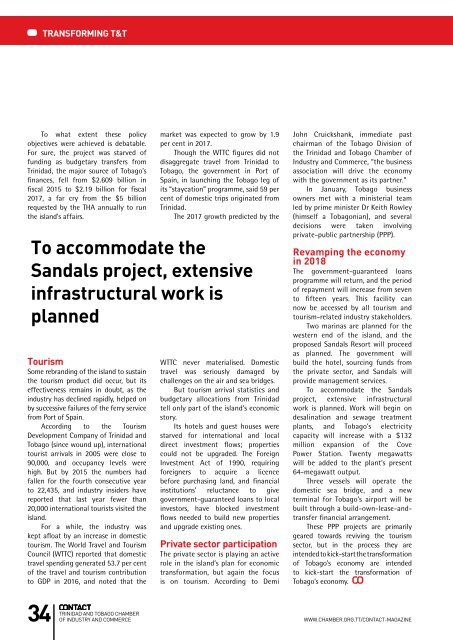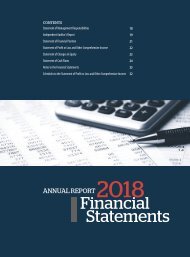You also want an ePaper? Increase the reach of your titles
YUMPU automatically turns print PDFs into web optimized ePapers that Google loves.
transforming t&T<br />
To what extent these policy<br />
objectives were achieved is debatable.<br />
For sure, the project was starved of<br />
funding as budgetary transfers from<br />
Trinidad, the major source of Tobago’s<br />
finances, fell from $2.609 billion in<br />
fiscal 2015 to $2.19 billion for fiscal<br />
2017, a far cry from the $5 billion<br />
requested by the THA annually to run<br />
the island’s affairs.<br />
Tourism<br />
Some rebranding of the island to sustain<br />
the tourism product did occur, but its<br />
effectiveness remains in doubt, as the<br />
industry has declined rapidly, helped on<br />
by successive failures of the ferry service<br />
from Port of Spain.<br />
According to the Tourism<br />
Development Company of Trinidad and<br />
Tobago (since wound up), international<br />
tourist arrivals in 2005 were close to<br />
90,000, and occupancy levels were<br />
high. But by 2015 the numbers had<br />
fallen for the fourth consecutive year<br />
to 22,435, and industry insiders have<br />
reported that last year fewer than<br />
20,000 international tourists visited the<br />
island.<br />
For a while, the industry was<br />
kept afloat by an increase in domestic<br />
tourism. The World Travel and Tourism<br />
Council (WTTC) reported that domestic<br />
travel spending generated 53.7 per cent<br />
of the travel and tourism contribution<br />
to GDP in 2016, and noted that the<br />
market was expected to grow by 1.9<br />
per cent in 2017.<br />
Though the WTTC figures did not<br />
disaggregate travel from Trinidad to<br />
Tobago, the government in Port of<br />
Spain, in launching the Tobago leg of<br />
its “staycation” programme, said 59 per<br />
cent of domestic trips originated from<br />
Trinidad.<br />
The 2017 growth predicted by the<br />
To accommodate the<br />
Sandals project, extensive<br />
infrastructural work is<br />
planned<br />
WTTC never materialised. Domestic<br />
travel was seriously damaged by<br />
challenges on the air and sea bridges.<br />
But tourism arrival statistics and<br />
budgetary allocations from Trinidad<br />
tell only part of the island’s economic<br />
story.<br />
Its hotels and guest houses were<br />
starved for international and local<br />
direct investment flows; properties<br />
could not be upgraded. The Foreign<br />
Investment Act of 1990, requiring<br />
foreigners to acquire a licence<br />
before purchasing land, and financial<br />
institutions’ reluctance to give<br />
government-guaranteed loans to local<br />
investors, have blocked investment<br />
flows needed to build new properties<br />
and upgrade existing ones.<br />
Private sector participation<br />
The private sector is playing an active<br />
role in the island’s plan for economic<br />
transformation, but again the focus<br />
is on tourism. According to Demi<br />
John Cruickshank, immediate past<br />
chairman of the Tobago Division of<br />
the Trinidad and Tobago Chamber of<br />
Industry and Commerce, “the business<br />
association will drive the economy<br />
with the government as its partner.”<br />
In January, Tobago business<br />
owners met with a ministerial team<br />
led by prime minister Dr Keith Rowley<br />
(himself a Tobagonian), and several<br />
decisions were taken involving<br />
private-public partnership (PPP).<br />
Revamping the economy<br />
in <strong>2018</strong><br />
The government-guaranteed loans<br />
programme will return, and the period<br />
of repayment will increase from seven<br />
to fifteen years. This facility can<br />
now be accessed by all tourism and<br />
tourism-related industry stakeholders.<br />
Two marinas are planned for the<br />
western end of the island, and the<br />
proposed Sandals Resort will proceed<br />
as planned. The government will<br />
build the hotel, sourcing funds from<br />
the private sector, and Sandals will<br />
provide management services.<br />
To accommodate the Sandals<br />
project, extensive infrastructural<br />
work is planned. Work will begin on<br />
desalination and sewage treatment<br />
plants, and Tobago’s electricity<br />
capacity will increase with a $132<br />
million expansion of the Cove<br />
Power Station. Twenty megawatts<br />
will be added to the plant’s present<br />
64-megawatt output.<br />
Three vessels will operate the<br />
domestic sea bridge, and a new<br />
terminal for Tobago’s airport will be<br />
built through a build-own-lease-andtransfer<br />
financial arrangement.<br />
These PPP projects are primarily<br />
geared towards reviving the tourism<br />
sector, but in the process they are<br />
intended to kick-start the transformation<br />
of Tobago’s economy are intended<br />
to kick-start the transformation of<br />
Tobago’s economy.<br />
34<br />
Trinidad<br />
and Tobago Chamber<br />
of Industry and Commerce<br />
www.chamber.org.tt/contact-magazine

















